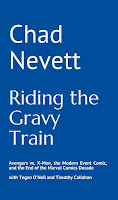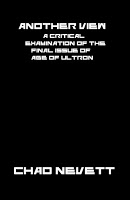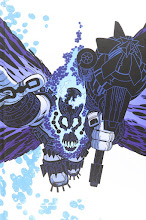Wrote this earlier today for the school paper, the University of Windsor Lance. Very cursory, but it hits the main points.
52 Vols. 1-3
By: Geoff Johns, Grant Morrison, Greg Rucka, Mark Waid, Keith Giffen and various artists
DC Comics
302 pgs., $23.99 (each)
Last year, the comics published by DC all jumped ahead one year in their stories and to fill in that missing year, the publisher put out a weekly comic told in real time. Weekly comics are not new ideas, but by telling the story in real time as well as tapping four of the industry’s top writers, 52 managed to capture the audience for the entire year. Now, the year-long saga has been collected in four trade paperbacks (volume four available in November) for easy-reading.
The tagline for 52 was that it was a year without Superman, Batman and Wonder Woman as all three recovered from the most recent intercompany crossover event, Infinite Crisis. This means that 52 focuses on a cast of lesser known, often looked down upon characters with varying results.
In one story, the time-travelling Booster Gold is a superhero only so he can get corporate sponsorship and his costume is plastered with company logos. In another, Lex Luthor has found a way to give the average person superpowers and the hero Steel has to figure out what he’s up to before it’s too late. In the most poignant story, the anti-hero Black Adam goes through a startling transformation as he builds a family, turning his back on his former hard-line stances.
However, while these stories are among the better ones, there are also clunkers like the plot involving former police detective Renee Montoya and the faceless vigilante The Question as they track the plans of Intergang, which is, well, an international gang. A lot of space is given to this story, but it’s highly repetitive and lacks an interesting hook.
Beyond those plotlines, there are easily another half-dozen touched on in these three volumes, so these books could be overwhelming for someone who isn’t familiar with DC’s cast of characters. If there is a fatal flaw in 52, it’s that extensive knowledge of the DC universe is a necessity, but that is offset by the fact that the series is aimed at hardcore fans.
The use of real time is interesting, but sometimes hurts more than it helps. Plots are often dropped for several weeks and then pick up as if no time has passed in between. Having so many balls in the air and limited space means that only a few stories can be touched on per chapter, but leaving some stories alone for nearly two months is sloppy.
As well, specific fans of the writers involved may be disappointed as the method of writing comes off as more written-by-committee--and necessarily so to maintain a coherent tone. There are flashes of individual style, but not many. The overall style used, though, is not bad, but may disappoint some who see a name like Grant Morrison on the cover and then fail to see his trademark style.
The art on 52 is provided by various artists as keeping up with a weekly deadline is beyond most, but, to provide a consistent tone, artist Keith Giffen provides layouts for all of the art. The style of art may change, but since Giffen provides a guide for panel placement and the composition of the drawings, the general tone and look remain remarkably steady.
52 may not be the best book for someone not familiar with the various intricacies of the DC universe, but the year-long weekly book was an interesting experiment in storytelling and these collections are worth it just to see the various tricks and techniques used to pull it off. As well, the collections come with creator commentary for each chapter and other bonuses, providing a great look into what it took to make this book work.
***
I'll do a post on volume three this week along with stuff on the comics I bought on Friday.
skip to main |
skip to sidebar
"Chad Nevett is the spicy mustard of comics reviews" -- Adam Langton, Lovable Fucker and Chad Nevett's Best Man
About
GraphiContent was a blog featuring comic criticism, commentary, analysis, theory and discussion. Oh, and the odd rant, review or totally random post.
Chad Nevett has a BA in English and political science, and an MA in English Language & Literature--Creative Writing. He was a reviewer for Comic Book Resources, blogger for Comics Should be Good, and writer for 411mania. He resides in Windsor, Ontario with his wife and her cat. He can be reached at chevett13[at]yahoo[dot]ca.
Notable Posts (In Chronological Order)
- The Future is X-Rated: Marvel Boy, the Modern World, and the History of the Marvel Universe
- A Music Video on Paper: The Final Chapter of Codeflesh
- Tony Stark, Futurist
- "All you need is fuck."
- Man v. Superman
- Civil War v. Infinite Crisis
- Building a Better Batman: Grant Morrison's First Year on Batman
- U.S. v. T.H.E.M. with Little Ol' Me Stuck in the Middle
- Mark Millar's Ultimate X-Men
- Building a Better Batreader: Grant Morrison's Second Year on Batman
- Secret Invasion Reading Order (Updated June 29, 2013)
- Top 25 Warren Ellis Comics (Oct. 2009)
- Building a Better Batfamily: Grant Morrison's Third Year on Batman (and Robin)
- You Don't Just Want to Break Me, You Want to Tear Me Apart
- 50 Things I Learned in My Three Years and Four Months as a Reviewer for Comic Book Resources
- Avengers vs. X-Men Reading Order (Updated August 17, 2013)
Notable Collections of Posts (In Semi-Chronological Order)
- Joe Casey Comics Archive
- Countdown to Who Cares?
- The Chad and Steve Q&A Series
- I've Got 52 Problems, but a Bitch ain't One
- Best of 2007
- Hello Cosmic: The Works of Jim Starlin Archive
- Chad's Jackass Comic Creator Interviews from 2001
- The Superman 2000 Pitch (with Tim Callahan)
- Raymond Chandler's "Twelve Notes on the Mystery Story"
- Best of 2008
- Blogathon 2009: Brian Michael Bendis's Avengers
- Best of 2009
- Art Discussion Month 2010
- Five Years Blogging: A Life Well Wasted (with David Brothers)
- Booze, Broads & Bullets: Sin City
- Blogathon 2010: Hellblazer (and Hellblazer Posts Beyond the Blogathon)
- Best of 2010
- 28
- Blogathon 2011: Superhero Comics of the Past Decade
- Best of 2011
- Riding the Gravy Train (Avengers vs. X-Men) Archive
- Blogathon 2013: Comics Critics All-Stars
- Best of 2012
Links
Blogs Worth Reading
-
-
-
-
-
-
The Mighty Crusaders Number Four #031 month ago
-
The Last Thorsday1 month ago
-
Everybody’s Rockin’6 months ago
-
-
Social (Science) Fiction8 months ago
-
The Rest of the Cruise1 year ago
-
-
-
-
Untitled 1:5 years ago
-
Farewell, sweet prince6 years ago
-
Hello World6 years ago
-
-
-
That’s a wrap.9 years ago
-
episode 026: exit the world10 years ago
-
-
Books Read in 201211 years ago
-
Building Stories - Suggested Reading Order11 years ago
-
Final Crisis #715 years ago
-
Riding the Gravy Train: Avengers vs. X-Men, the Modern Event Comic, and the End of the Marvel Comic
Another View: A Critical Reading of the Final Issue of Age of Ultron
GØDLAND CELESTIAL EDITION THREE
Shot in the Face: A Savage Journey to the Heart of Transmetropolitan
Keeping the World Strange: A Planetary Guide
Minutes to Midnight: Twelve Essays on Watchmen
Writing Without Direction: 10 1/2 Short Stories by Canadian Authors under 30
Blog Archive
-
▼
2007
(252)
-
▼
September
(10)
- 52 Problems, Etc. (Volume Lance)
- The Greatest Comics You've Never Read 002: Marvel ...
- The Greatest Comics You've Never Read 001: Avenger...
- 52 Problems etc. (Volume Adam)
- 52 Problems, Etc. (Volume 2.714285714285, etc.)
- I've Got 52 Problems but a Bitch Ain't One (Volume...
- I've Got 52 Problems and a Bitch Ain't One (Volume...
- Batman Thinks Your Favourite Hero is a Loser
- Comics are closer now
- Bitch-Slapped
-
▼
September
(10)






